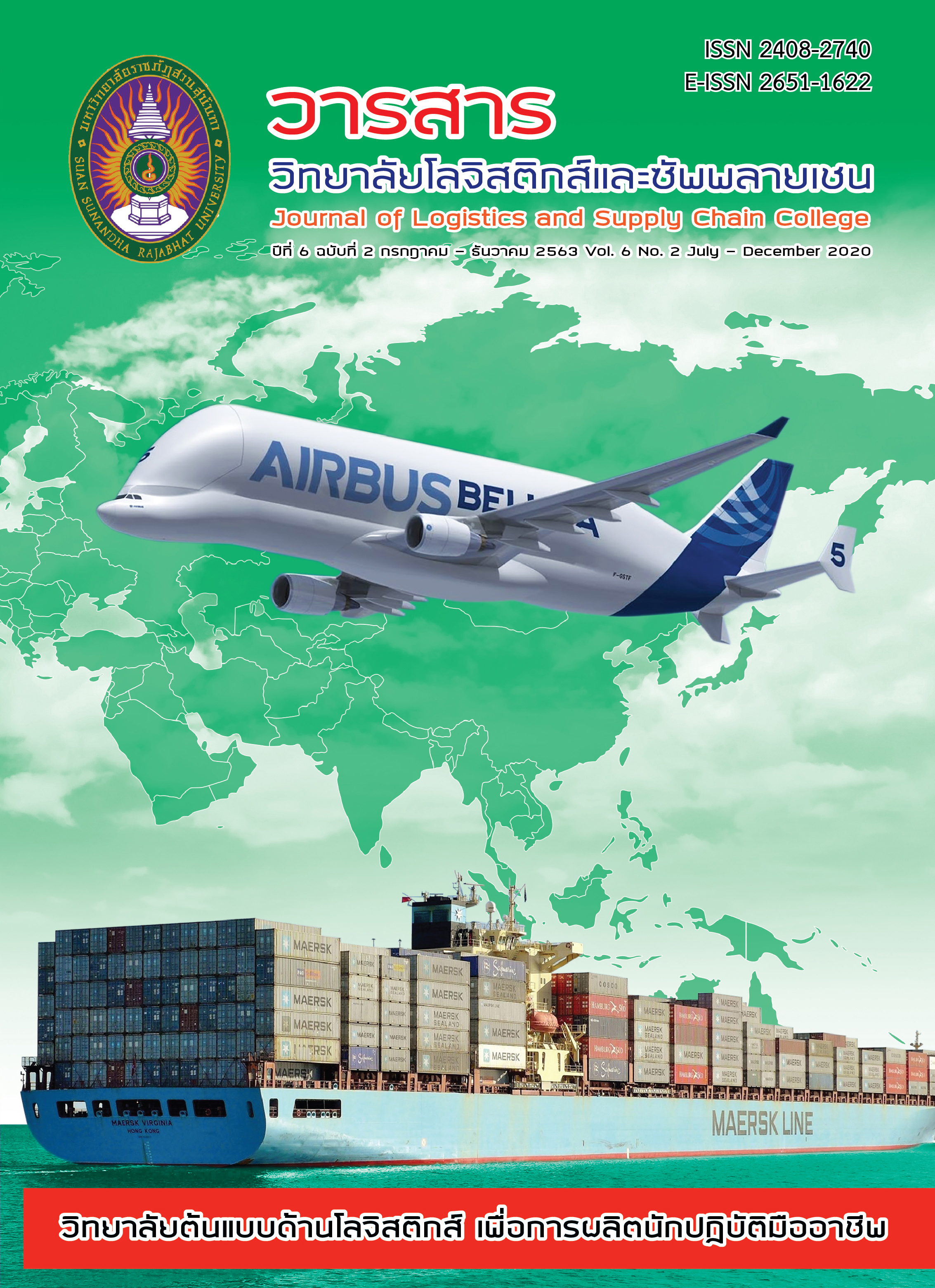Designing and Automated Guided Vehicle (AGV) Routh with Simulation Model and Analystic Hierarchy Process(AHP): A Case Study of XYZ Company
Abstract
The objective of this research is 1) Propose a path design method for automated moving equipment that can reduce lead times and 2) Present the factors for selecting the optimal AGV route. Using a quantitative research model. The research area is the automotive parts factory of the case study company. The sample group consisted of 2 executives and employees at the Company's manufacturing plant. The case study was 9 people using a specific selection method. And set a quota The research instruments were 1) process flow charts, 2) simulation techniques, and 3) hierarchical analysis decision-making processes. The data were analyzed by using Statfit3 program. Hypothesis testing was done by Chi-square test. The results of the research showed that 1) 39.9% decrease in the mean waiting time, 40.7% decrease in the waiting average AGV, and 2.9% increase in the employee utility of the type 3. Distance was reduced by 55.75%, cost decreased by 55.05% and 2) The most influential factors in assessing the suitability of the mobility path of the moving equipment were 1) average process waiting time 47.34% 2) Average AGV waiting 22.16% 3) Cost of movement 14.68% 4) Total distance of movement 11.71% and 5) Employee utility 4.08%. Different workflow or อehicle paths within a plant directly affect the efficiency of operations and the determining factors of different industries have different objectives and results.
References
ดวงใจ จันทร์ดาแสง. (2558).ปัจจัยที่มีผลต่อประสิทธิภาพการให้บริการขนส่งด้วยตู้คอนเทนเนอร์ : กรณีศึกษาบริษัทอุตสาหกรรม ในเขตบางนา กรุงเทพมหานคร. วารสารวิทยาลัยโลจิสติกส์และซัพพลายเชน, 1(1),26-32.
ผ่องใส เพ็ชรรักษ์. (2558). การบริหารจัดการอย่างยั่งยืนในโซ่อุปทานผลิตภัณฑ์รถยนต์นั่ง. รายงานวิจัย, มหาวิทยาลัยรังสิต.
พัฒนพงศ์ น้อยนวล. (2555). การปรับปรุงกระบวนการขนส่่งภายในคลังสินค้าโดยใช้แบบจำลองสถานการณ์กรณีศึกษาอุตสาหกรรมน้ำอัดลม. วิทยานิพนธ์ภาควิชาการจัดการโลจิสติกส์ คณะบัณฑิตวิทยาลัยการจัดการและนวัตกรรม, มหาวิทยาลัยเทคโนโลยีพระจอมเกล้าธนบุรี.
รุ่งรัตน์ ภิสัชเพ็ญ. (2553). คู่มือสร้างแบบจำลอง ARENA. พิมพ์ครั้งที่ 2. กรุงเทพฯ: สำนักพิมพ์ซีเอ็ดยูเคชั่น. วลัยพร ปราศจากและคณะ. (2560). การปรับปรุงผังโรงงานด้วยหลักการออกแบบผังโรงงานอย่างเป็นระบบ กรณีศึกษา โรงงานผลิตดักท์แอร์. ปริญญานิพนธ์วิทยาลัยนวัตกรรมทางด้านเทคโนโลยีและวิศวกรรมศาสตร์, มหาวิทยาลัยธุรกิจบัณฑิตย์
วุฒิชัย วงษ์ทัศนีย์กร. (2556). การวิเคราห์แบบจำลอง. พิมพ์ครั้งที่ 2. กรุงเทพฯ: สำนักพิมพ์มหาวิทยาลัยธรรมศาสตร์.
ศุภลักษณ์ ใจสูง. (2554). การคัดเลือกผู้ให้บริการโลจิสติกส์ของบริษัทฮานาไมโครอิเล็คโทรนิคส จำกัด (มหาชน) เขตนิคมอุตสาหกรรมภาคเหนือ โดยใช้กระบวนการตัดสินใจแบบวิเคราะห์ลำดับชั้น. การค้นคว้าอิสระบริหารธุรกิจมหาบัณฑิต สาขาวิชาการบริหารธุรกิจ, มหาวิทยาลัยเชียงใหม่
เสาวภา มหาคีตะ. (2557). แบบจำลองการจัดการกระบวนการรับสินค้าอุปโภคบริโภคของศูนย์กระจายสินค้า. วิทยานิพนธ์สาขาวิชาสถิติประยุกต์, สถาบันเทคโนโลยีพระจอมเกล้าเจ้าคุณทหารลาดกระบัง.
อดิศักดิ์ ธีรานุพัฒนาและชูศรี เที้ยศิริเพชร. (2554). การจัดลำดับความสำคัญของมาตรวัดและกระบวนการหลักของโซ่อุปทานโดยวิธีแบบจำลองกระบวนการตัดสินใจแบบวิเคราะห์ลำดับชั้น (AHP). จุฬาลงกรณ์ธุรกิจปริทัศน์, ฉบับที่ 121 (กรกฏาคม-กันยายน), 63-82



